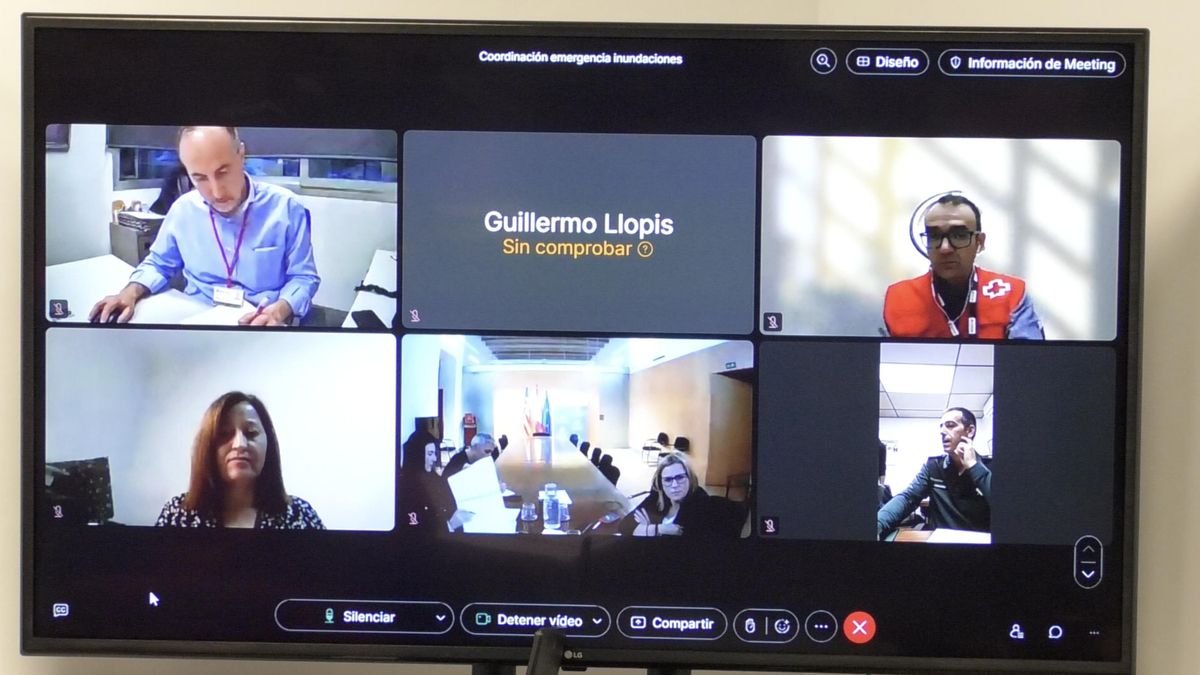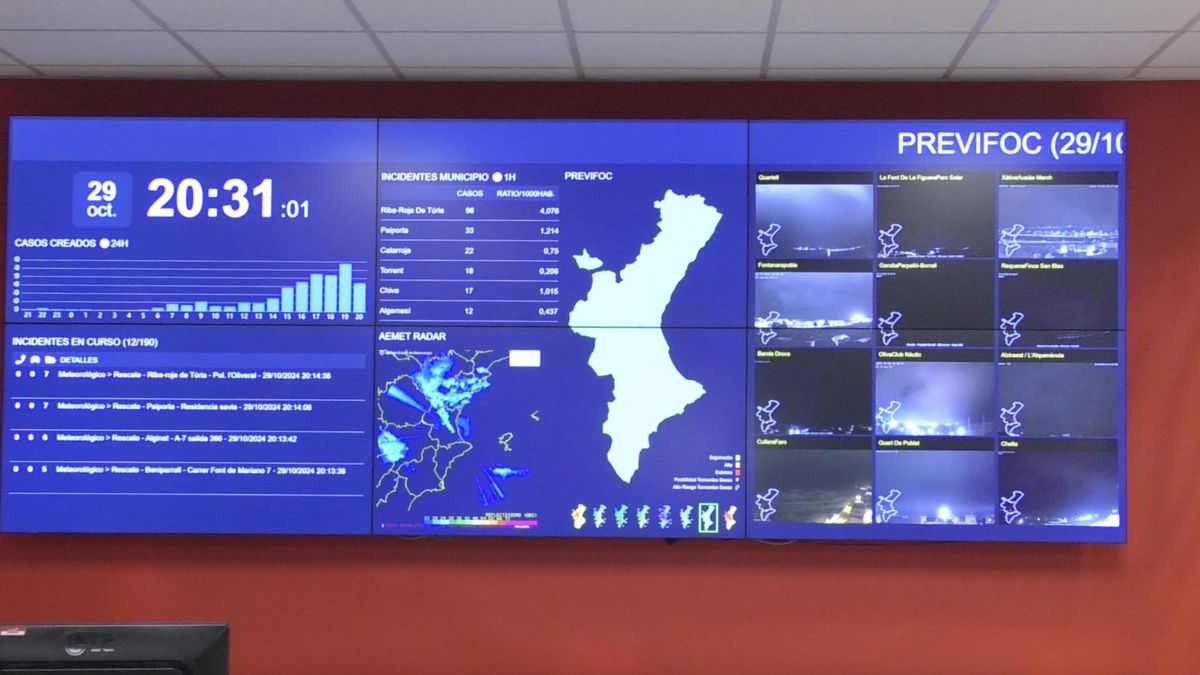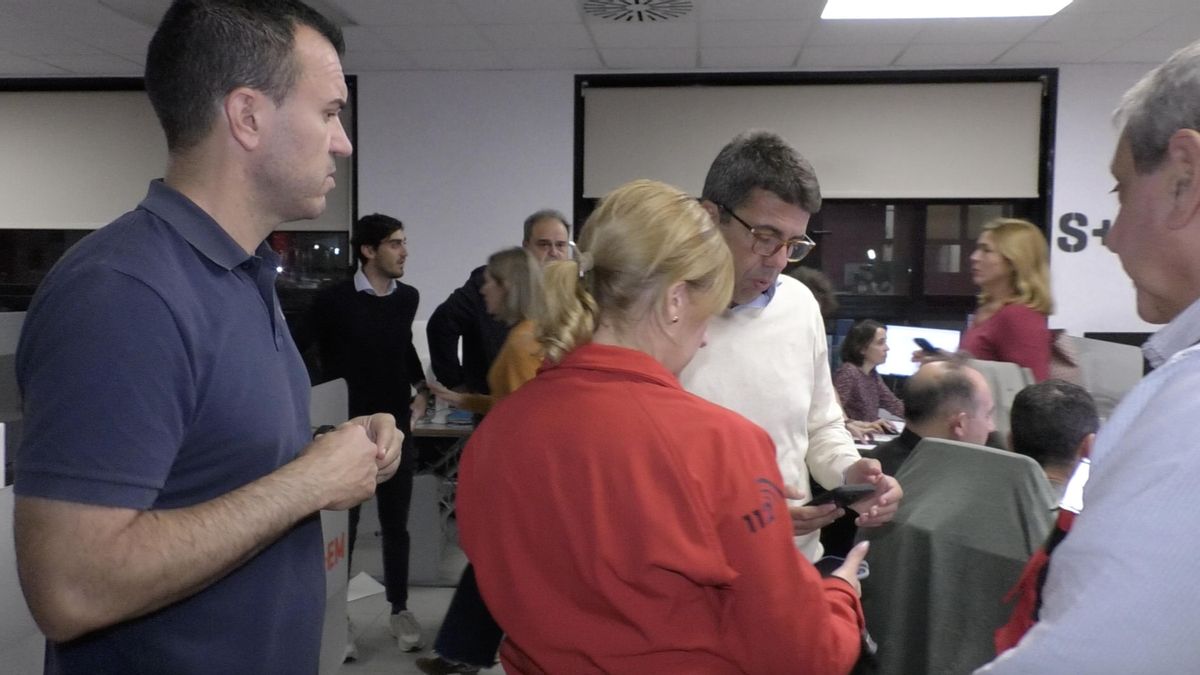It is already a proof of the cause of the Dana. The video that recorded a producer hired by Emergencies of the Generalitat with fragments of the Integrated Operational Coordination Center (Cecopi) shows that the ES-Alert sending from the beginning was considered; That the then consellera Salome Pradas gave orders and exercised, bad that, the “Single Command” of the response to the catastrophe, and that the Deputy Director General of Emergencies, Jorge Suárez, glimpsed the stage of L'Albufera, the natural park where the Rambla del Poyo pours.
The Generalitat hid Judge Nuria Ruiz Tobarra the existence of the video. In the response of March 4 to a requirement of the instructor, the Autonomous Emergency Secretary, Irene Rodríguez, affirmed that “there is no documentary support” of the Cecopi meeting. Although the public company of which her husband was manager, Raúl Quíz, had a producer to record in emergency situations and that the Generalitat, according to the award specifications, had the images in her possession. The delivery of the images was also denied to a socialist deputy and in the Investigation Commission of the Corts Valencianes.
The Mazón Executive, with the competence by law of emergency response, has tried to hide at all costs the trail of any image of the questioned Cecopi on October 29.
The existence of the images was revealed by Eldiario.es on September 15. Until that time, only a brief recording of the Cecopi (of just over a minute) made by the Aemet weather chief in Valencia, José Ángel Núñez, one of the main witnesses of the cause. A recording that, despite the tremendous offensive against Núñez (with a Minón Government Minister that was even allowed to call it on social networks of “meteorologist/spy”) was endorsed as a “fully” evidence lawful by the instructor judge.
In the absence of an official recording, any audiovisual file results from enormous relevance for a procedure whose instructor has received all kinds of attacks, even personal.
There were also a six -minute resource images that à Punt recorded at 18.59, when the Cecopi had been paused for an hour. The images were never broadcast on public television (hiding that the emergency press manager, Aurora Roca, had asked that the sound was not used) nor the instructor judge, despite the undoubted interest of the audiovisual material for a cause investigating 229 alleged reckless homicides. The existence of the images was known when they arrived at the hands of Spanish Television and the public chain issued them, according to their informative interest.
The à tip video complement
The full video of the recording, already in the hands of the judge and published by this newspaper, shows the inoperance of the Cecopi meeting when, from 18.59, it was time since L'Horta Sud was flooded as a result of the ravine of the poyo, whose overflow caused most deaths. However, à Punt kept in a drawer a recording of raw images of that precise moment of the Cecopi, without having captured other moments of the meeting.
On the contrary, the Chamber of the Producer hired by Emergencies of the Generalitat registered resource plans from the beginning of the meeting, which was summoned at 17.00, but that formally began a quarter of an hour later due to the telematic connection problems. An image of the provincial fire deputy clock, Avelino Mascarell, temporarily places the first recordings of the camera operator at 17.10.
The succession of resource plans throughout the tragic afternoon allows to rebuild some Cecopi fragments, with an emergency director (Alberto Martín Moratilla) that exposes a kind of presentation of the meeting while his superior, the regional secretary Emilio Argüeso, remains silent, a discreet dynamic that the current accused would maintain all the time, according to several witnesses.
With “the present Minister,” says Martín Moratilla, “we are going to report the whole situation how the forecast and the media we have displaced.” The general director focuses the focus “mainly” on the “Requena Zone”, affected by floods from the first 14.00 and with the Emergency Military Unit (UME) mobilized from 15.30. “We have no land access,” Jorge Suárez, deputy general emergency deputy director in another of the videos.
Suárez's references Al Es-alert and L'Abufera
Another of the keys that the videos that the Generalitat hid the judge is a phrase by Jorge Suárez at the beginning of the meeting: “According to what we decide, we can send a message to all the mobiles in that area, which is one of the decisions we can make.” An affirmation, among others, that questions the version that the former Conssellera Pradas has maintained even before its imputation in the procedure.
Fragmentary videos also capture Suárez referring to Lake L'Albufera, the natural space to which the Poyo ravine pours. “We have entering the area of L'Abufera very high intensities again and, in addition, we have a planned unparallele (…).”
Then the then chief inspector of the Provincial Firefighters Consortium, José Miguel Basset, describes the operation in the Plana de Utiel-Requena and alerts that there is hardly “an hour of light”. Basset continues with the explanation: “The Dana has stagnated in the Plana of Requena-Utiel, is affecting the population of Utiel and, specifically (…).”
The Chamber focuses on the agencies connected telematically: a representative of the Red Cross is observed, to a Civil Guard command and the Government delegate, Pilar Bernabé, accompanied by his press manager and his chief of cabinet. These are the agencies that, shortly after, would keep the screen in black in several successive pauses of the meeting, despite the key role of organisms such as the Armed Institute.

“They are telling us that we have people who can't get out of there, people on the roofs, who just checked it (…),” adds the Chief Fire inspector. “Calculate that we will begin to have hypothermia problems,” he adds while a sigh for the panorama that Basset paints and the camera records the laptop of one of the participants, which consults a map of Utiel is heard in the background.
“We are in a fairly complex situation, this is what I can inform you from what is the Valencia Firefighters Consortium,” concludes the Chief Inspector, who holds a kind of microphone while remains pounced on the table.
Salvador Romón, commander of the UME, says below: “(La) idea (s), when we allow us to get to work. We have taken a complete section, now 55 military and 36 vehicles. We will take another six to have about 12 media plus two load trucks.”
“Can't you enter until, let's say, love the current?” Asks the Government delegate, Pilar Bernabé. “Affirmative,” replies the Romon Commander. After the first interventions, at the Cecopi meeting they try to solve technical connection problems.
Pradas, about Es-Alert: “Let's read it”
The images take a leap until after the first pause of the Cecopi, around 19.00, and Salomé Pradas manifests: (…) level 2 according to the Confederation (Hydrographic of Júcar), we are going to proceed to communication to the populations, or possible populations affected by the emergency “(presumably by the prey of Forata).
“We are going to read it,” Pradas proposes in reference to the eraser of the first message of ES-Alert. And Jorge Suárez begins reading: “Given the situation derived from heavy rains (…).”
The images are cut as the camera operator records resource plans, hence the fragmentary nature of the test. “Keep in mind that they will receive it with emergencies, which already knows the channel,” says Suárez below.
Then, Pradas indicates in Valencian: “Posem also of the communication, that Només will be 112 (…)” (“We also put the communication routes, which will only be 112.” In the following plane, the Minister insists on the content of the message: “Please, the 112 hp arroba, okay? Official channels.”
From 19.02, the images captured by the producer's camera operator hired by emergencies are complemented with those of the raw video of six minutes of à punt. The Cecopi has decided to reconnect telematic participants who have been in the molten screen to black and meadows calls for someone to call Miguel Polo, president of the Júcar Hydrographic Confederation (CHJ), and expresses that he does not feel like talking to him.
“Do we know something more than Utiel?” Asks Salome Pradas. “That we still can access,” replies José Miguel Basset.
The images contributed to the judge for emergencies of that phase of the Cecopi are much shorter – you can add a minute and 17 seconds – than the six -minute video that à punt recorded.
The explanation of Pradas to Mazón: “An explosion”
The last batch of producer videos with resource plans also provides key relevant on cars day. Immediately after the arrival of President Carlos Mazón to the complex of the Emergency Coordination Center – at 20.28, according to their latest version of the events – Pradas, Mompó, Martín Moratilla and Suárez are located behind two technicians in the Command and Control Chamber.

Salomé Pradas, in imperative tone, specifies the technicians: “Before sending the following message (from ES-Alert), I want to see it.”
Mazón said in his first appearance in the Corts Valencianes after the catastrophe, on November 15, that upon his arrival at the Cecopi “it was not necessary for anyone” to “update” the situation. However, about 20.30 (as can be seen from the clock on the screen of the command and control room), Pradas explains to a somewhat dislocated Mazón that an “meteorological never known, that is the word” has been experienced. “An explosion,” adds the Minister.
The camera operator takes some planes of the Emergency Center screen, which details the incidents that 112 has collected in a list of populations such as Riba-Roja del Túria, Paiporta, Catarroja, Torrent, Chiva and Algemesí. At another immediately later time, Mazón expresses his surprise due to not having coverage on his mobile phone.
In the background, a member of the Pradas Cabinet is observed; To an external advisor to Mazón, Josep Lanuza, and the president's head of the president, the general director Maite Gómez. Sitting, the technicians of the Command and Control Chamber of the Emergency Center follow theirs with half a dozen politicians and advisors behind them.

“I don't understand it,” says Mazón in reference to the fall of the telephone company in that area. “But does it happen to me?” Asks the Chief of the Consell, something misplaced. “No, everyone,” says Vicente Mompó. Pradas offers her phone: “I have Vodafone and you can talk.”
“And I will be without coverage all the time?” Carlos Mazón asked again.